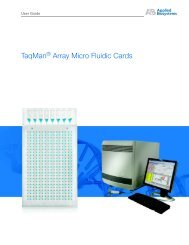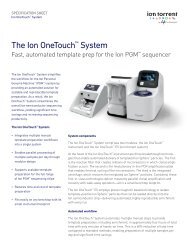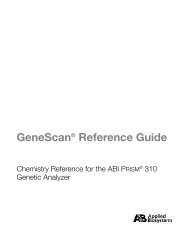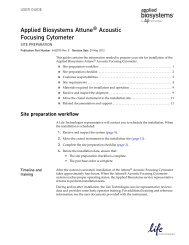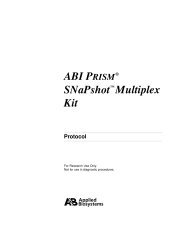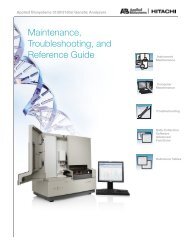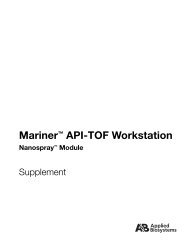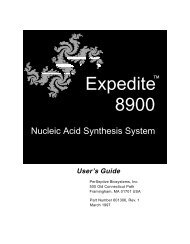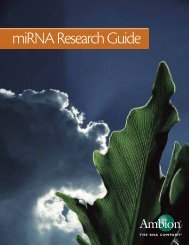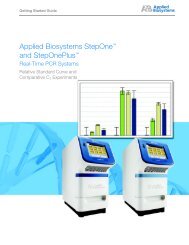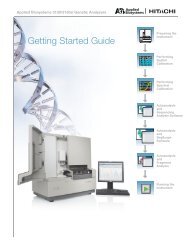Applied Biosystems SOLiD™ 4 System SETS Software User Guide ...
Applied Biosystems SOLiD™ 4 System SETS Software User Guide ...
Applied Biosystems SOLiD™ 4 System SETS Software User Guide ...
Create successful ePaper yourself
Turn your PDF publications into a flip-book with our unique Google optimized e-Paper software.
Sampling<br />
Allele ratio<br />
<strong>Applied</strong> <strong>Biosystems</strong> SOLiD 4 <strong>System</strong> <strong>SETS</strong> <strong>Software</strong> <strong>User</strong> <strong>Guide</strong><br />
Appendix B Advanced Topic: Data Analysis Overview<br />
Data analysis considerations B<br />
If coverage at a genome position is low, the second allele might often<br />
not be sampled, even if it is present. Heterozygotes are expected to be<br />
underrepresented at low coverage. (They can be called as a<br />
homozygote for one of the two alleles.) It is important to have a low<br />
false positive rate for SNP detection, because SNPs are expected to<br />
exist at only 1 in 1,000 positions for humans and some other species.<br />
The false positive rate in an individual species should be at least an<br />
order of magnitude lower than this, to avoid a high false discovery<br />
rate. An error model that incorporates quality values (QV) can<br />
increase the overall accuracy of SNP detection. The SNP detection<br />
algorithms of the SOLiD 4 <strong>System</strong> use explicit error models<br />
generated from each run and biologically meaningful prior<br />
probabilities to evaluate evidence of a SNP. 2-base encoding provides<br />
a built-in way to distinguish errors from true alleles to manage the<br />
false positive rate.<br />
If the sample preparation method or some other cause produces<br />
results in allele ratios that are considerably different from the<br />
expected 50:50 ratio, it is more difficult to detect heterozygosity.<br />
Detecting heterozygosity then requires more sequence coverage.<br />
Find polymorphisms in color-space<br />
The SOLiD 4 <strong>System</strong> can detect complicated genomic variations<br />
such as adjacent SNPs, insertions, deletions, and structural<br />
rearrangements.<br />
For other analysis tools, visit the AB SOLiD <strong>Software</strong> Community<br />
website:<br />
http://www3.appliedbiosystems.com/AB_Home/applicationstechnol<br />
ogies/SOLiD<strong>System</strong>Sequencing/<strong>Software</strong>CommunityDataAnalysis<br />
ResourcesforScientistsDevelopers/index.htm<br />
An example of various polymorphisms in color-space is shown in the<br />
figure below.<br />
155



